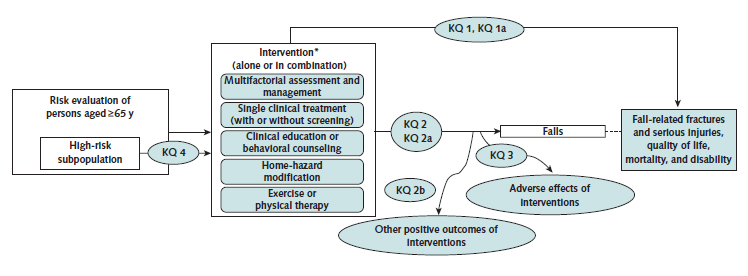Analytic framework for USPSTF review on interventions to reduce falls and fall-related outcomes

Figure 2 is an analytic framework that depicts the events that older adults experience while undergoing primary care interventions to prevent falls. The framework includes six groupings: Risk Evaluation, Intervention, Intermediate Outcomes, Health Outcomes, Other Positive Outcomes, and Adverse Effects. The patient population undergoing risk evaluation is adults aged 65 years and older; the subpopulation for key question 4 (How are high-risk older adults identified for primary care fall interventions?) is adults who are considered at high risk for falling. The intervention is one of the following (alone or in combination): multifactorial assessment and management; single clinical treatment, with or without screening; clinical education or behavioral counseling; home hazard modification; and exercise or physical therapy. The intermediate outcome, which is used to determine if the intervention is effective, is number of falls/fallers. The health outcomes include a reduction in fall-related fractures and serious injuries, improvement in quality of life, and reduction in disability or mortality. Other positive outcomes include a reduction in fear of falling and improvement in balance, gait, and mobility measures. Minor adverse outcomes associated with specific interventions include: increased fall-related outpatient visits after comprehensive falls assessment; self-reported musculoskeletal complaints (but not outpatient visits or hospitalizations) with exercise interventions; increased outpatient visits for abnormal heart rhythm with exercise intervention; minor local skin irritation or infection with use of hip protectors; gastrointestinal side effects with liquid protein-energy supplementation; and transient or asymptomatic hypercalcemia and hypercalciuria with vitamin D supplementation.
Key Questions
KQ1: Is there direct evidence that primary care interventions reduce fall-related injury, improve quality of life, reduce disability, or reduce mortality when used alone or in combination to reduce falls in community-dwelling older adults?
KQ1a: Do these interventions reduce injury, improve quality of life, reduce disability, or reduce mortality in older adults specifically identified as high risk for falls?
KQ2: Do primary care interventions used alone or in combination in community-dwelling older adults reduce risk or rate of falls or fallers?
KQ2a: Do these interventions reduce falls in older adults specifically identified as high risk for falls?
KQ2b: Are there positive outcomes other than reduced falls, and related morbidity and mortality, that result from primary care fall interventions?
KQ3: What are the adverse effects associated with interventions to reduce falls?
KQ4: How are high-risk older adults identified for primary care fall interventions?
* Expanded intervention list:
Multifactorial assessment and management includes multifactor risk assessment, comprehensive geriatric assessment, and ≥2 of the following screenings for fall risk: vision, gait, mobility, strength, medication review, cognitive impairment, orthostatic hypotension, and environmental risks.
Clinical education or behavioral counseling includes exercise, fall risk reduction, and a home-hazard checklist.
Home-hazard modification includes identifying and removing potential fall hazards, adding grab bars and handrails, and modifying the environment to improve mobility and safety.
Exercise or physical therapy includes physical exercise, mobility and gait training, muscle strengthening, balance training, and training for recurrent fallers.
KQ = key question; USPSTF = U.S. Preventive Services Task Force.
Current as of: December 2010
